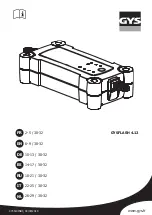
I01�High-voltage�Components
6.�Charging�the�High-voltage�Battery
109
These�checks�are�summarized�in�the�following�list:
•
Driving�readiness�off
•
Driving�speed�zero
•
Parking�lock�engaged
•
Charging�cable�connect�(proximity)
•
Communication�with�Electric�Vehicle�Supply�Equipment�OK�(pilot)
•
High-voltage�system�active�and�trouble-free.
When�all�prerequisites�for�charging�are�satisfied,�the�high-voltage�power�management�in�the�EME
requests�a�charging�power�from�the�power�electronics�in�the�EME�and�starts�the�charging�procedure.
The�EME�control�unit�sends�not�only�setpoint�values�for�the�charging�power,�but�also�specifies�limit
values�for�the�maximum�charging�voltage�and�the�maximum�charge�current.�These�values�are�based�on
the�current�condition�(e.g.�state�of�charge�and�temperature)�of�the�high-voltage�battery�and�according
to�the�power�requirement�of�the�rest�of�the�vehicle�electrical�system�(e.g.�for�climate�control).�The
EME�control�unit�cleverly�implements�these�setpoint�values,�i.e.�it�takes�into�consideration�not�only
the�setpoint�values,�but�other�marginal�conditions.�These�include�the�actual�status�of�the�electrical
machine�electronics�(fault,�temperature),�as�well�as�the�current�level�restricted�by�the�AC�voltage
network�and�the�charging�cable.
Only�when�the�communication�between�the�vehicle�(LIM)�and�Electric�Vehicle�Supply�Equipment
has�been�started�successfully�via�the�pilot�line,�is�the�voltage�applied�to�the�phase L1.�This�also�gives
further�protection�for�customers�and�Service�employees�against�the�dangers�of�electricity.
Activation�of�the�LEDs�for�displaying�the�charging�status
A�C-shaped�fiber-optic�conductor�runs�around�the�charging�socket�at�the�vehicle.�With�this�C-shaped
fiber-optic�conductor�it�is�possible�to�show�the�status�for�charging.�At�the�same�time,�this�fiber-optic
conductor�is�used�as�locator�lighting�for�the�charging�socket.�The�lighting�of�the�fiber-optic�conductor
is�effected�using�two�LEDs�which�are�controlled�by�the�LIM.
Locator�lighting:
The�locator�lighting�of�the�charging�socket�is�used�as�an
orientation�aid�by�the�driver�for�the�connection�and�disconnection
of�the�charging�plug.
The�two�LEDs�light�up�in�white�as�soon�as�the�charging�socket
cover�has�been�opened.�The�locator�lighting�remains�switched�on
as�long�as�the�bus�systems�are�active.�As�soon�as�a�charging�plug
has�been�identified�as�correctly�connected,�the�locator�lighting�is
switched�off�and�the�initialization�status�is�displayed.
















































